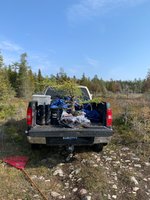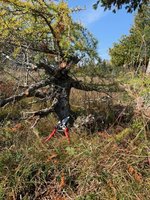mattspinniken
Omono
I was hoping the Bonsainut crew could help me brainstorm this. I just collected a beautiful larch yesterday, probably the best larch I have ever collected. The foliage looks very healthy on this big tree but I am quite sure that the trunk is hollow and the tree has a ton of ants in it. When I sawed a larger root near the base the root was hollow and it had about 50 ants come out.
Does anyone know if ants eat boring insects? This tree like most old larch has old evidence of borer damage, im more worried about bores than ants.
I did a light insecticide spray but I may try the Nick Lenz method and cover the tree with a tarp and spray the tree.



Does anyone know if ants eat boring insects? This tree like most old larch has old evidence of borer damage, im more worried about bores than ants.
I did a light insecticide spray but I may try the Nick Lenz method and cover the tree with a tarp and spray the tree.



